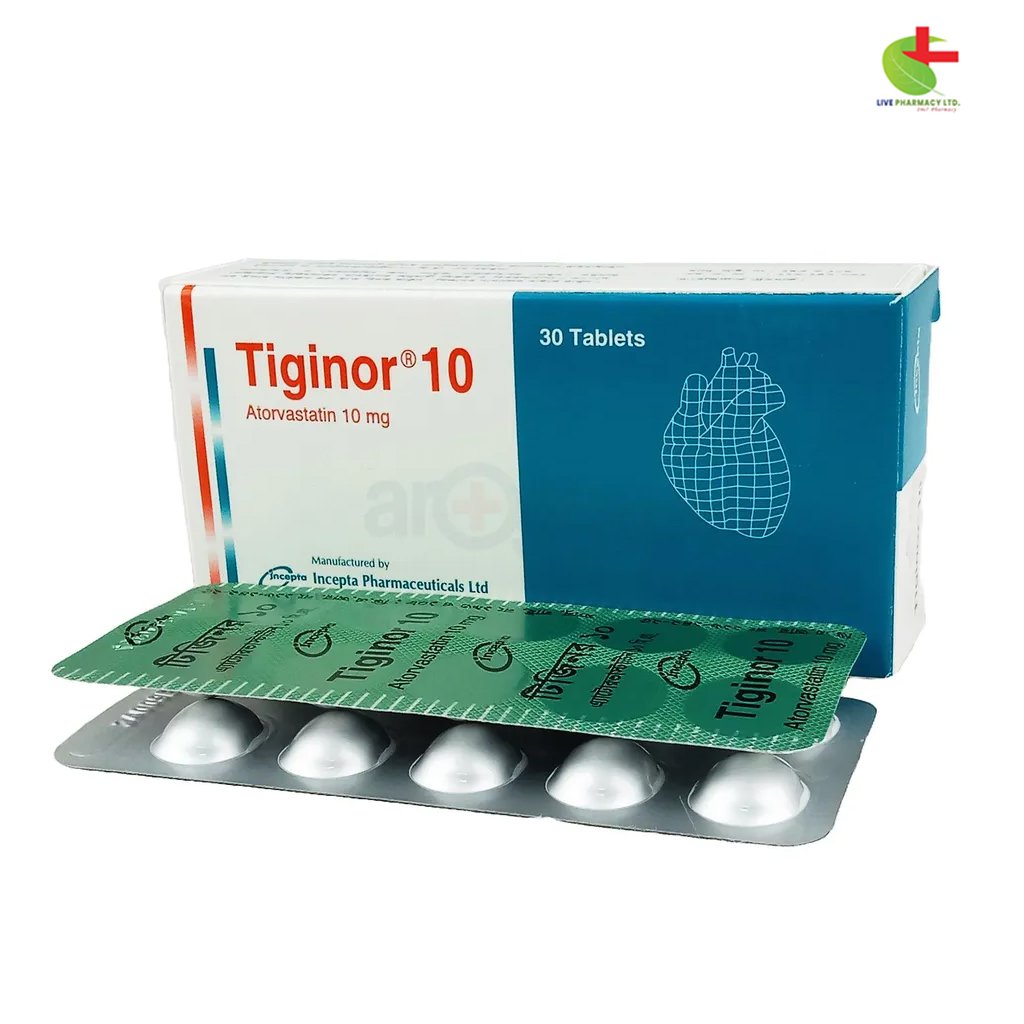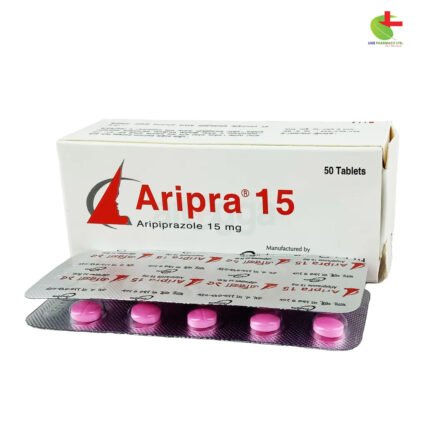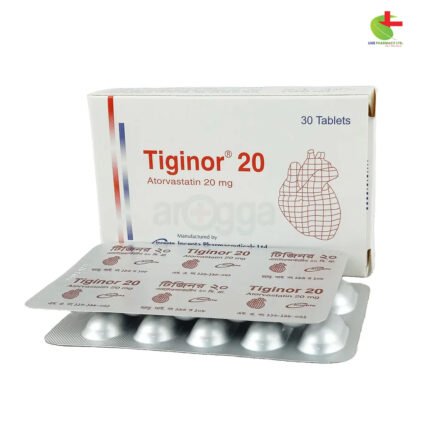Tiginor 10
115.00৳ Strip
- Tiginor is an effective adjunctive treatment for lowering total cholesterol, LDL cholesterol, and triglyceride levels.
- Indicated for familial hypercholesterolemia, mixed dyslipidemia, and hypertriglyceridemia.
- Works by inhibiting HMG-CoA reductase to reduce cholesterol synthesis.
- Always consult a healthcare professional for guidance on dosage and usage.
 Brand
Brand
|
Incepta Pharmaceuticals Ltd |
|---|---|
 Generics
Generics
|
Atorvastatin Calcium |
 Type
Type
|
Tablet |
Indications
Tiginor is prescribed as an adjunct to diet for lowering elevated total cholesterol, LDL cholesterol, apolipoprotein B (Apo-B), and triglyceride levels in patients who do not respond adequately to dietary and non-pharmacological interventions. It is indicated for:
- Reducing total and LDL cholesterol in patients with heterozygous and homozygous familial hypercholesterolemia.
- Lowering cholesterol and triglyceride levels in individuals with mixed dyslipidemia (Fredrickson Type Ia and Ib).
- Treating elevated triglyceride levels in hypertriglyceridemia (Fredrickson Type IV).
- Managing dysbetalipoproteinemia (Fredrickson Type III).
- Decreasing cardiac ischemic events in patients with asymptomatic or mild to moderate coronary artery disease and elevated LDL cholesterol.
- Lowering total and LDL cholesterol in patients with hypercholesterolemia exacerbated by diabetes mellitus or renal transplantation.
Always consult a registered healthcare professional before taking this medication.
Pharmacology
Atorvastatin, the active ingredient in Tiginor, selectively inhibits HMG-CoA reductase, the key enzyme responsible for converting HMG-CoA to mevalonate, a precursor to cholesterol. This action effectively reduces plasma cholesterol and lipoprotein levels by decreasing cholesterol synthesis in the liver and increasing the number of hepatic LDL receptors, enhancing LDL uptake and metabolism.
Absorption: After oral administration, Atorvastatin is quickly absorbed, with peak plasma concentrations reached within 1 to 2 hours. The degree of absorption increases with dosage. The absolute bioavailability of Atorvastatin is about 14%, with systemic availability of its HMG-CoA reductase inhibitory activity at approximately 30%.
Distribution: The mean volume of distribution for Atorvastatin is roughly 381 liters, with 98% protein binding. Atorvastatin is likely secreted in human milk.
Metabolism: Atorvastatin undergoes extensive metabolism to various active metabolites, which contribute significantly to its therapeutic effects. The drug is primarily metabolized by cytochrome P450 3A4, resulting in increased plasma concentrations when taken with known inhibitors like erythromycin.
Excretion: Atorvastatin and its metabolites are mainly eliminated via bile. The mean elimination half-life is about 14 hours, with the half-life of its inhibitory activity ranging from 20 to 30 hours due to active metabolites.
Dosage & Administration
For Primary Hypercholesterolemia and Combined Hyperlipidemia:
- Adults: Usually start at 10 mg once daily, with possible increases at 4-week intervals up to 80 mg.
- Children (Ages 10-18): Start at 10 mg once daily, increasing to a maximum of 20 mg as needed.
For Familial Hypercholesterolemia:
- Adults: Start at 10 mg daily, increasing to 40 mg at 4-week intervals, with a maximum of 80 mg daily.
- Children (Ages 10-18): Start at 10 mg once daily, increasing to a maximum of 80 mg as necessary.
For Prevention of Cardiovascular Events:
- Adults: Begin at 10 mg once daily, adjusting based on response.
Patients should follow a cholesterol-lowering diet prior to starting Atorvastatin, which can be taken at any time of day with or without food. Lipid levels should be monitored within 2 to 4 weeks after starting treatment, and dosage adjusted as needed.
Drug Interactions
Be cautious when using Tiginor with the following medications:
- Myopathy Risk: Increased with cyclosporine, fibric acid derivatives, niacin, erythromycin, and azole antifungals.
- Antacids: Co-administration may reduce Atorvastatin plasma levels by approximately 35%, but LDL reduction remains unaffected.
- Colestipol: Co-administration results in a 25% decrease in Atorvastatin plasma concentrations, yet enhances LDL reduction.
- Digoxin: Increased digoxin concentrations may occur; monitor patients accordingly.
- Erythromycin: Co-administration can increase Atorvastatin plasma concentrations by around 40%.
- Oral Contraceptives: AUC values for norethindrone and ethinyl estradiol may increase by about 30% and 20%, respectively.
Contraindications
Atorvastatin is contraindicated in patients with hypersensitivity to any component of this medication, active liver disease, or unexplained persistent elevations of serum transaminases.
Side Effects
Tiginor is generally well tolerated. Common side effects include:
- Constipation
- Flatulence
- Dyspepsia
- Abdominal pain
Other reported side effects may include infection, headache, back pain, rash, fatigue, and muscle pain.
Pregnancy & Lactation
Pregnancy: Atorvastatin is contraindicated during pregnancy due to the risk of congenital anomalies and adverse effects on fetal cholesterol biosynthesis. Treatment should be suspended in pregnant women or those planning to conceive.
Lactation: It is unknown whether Atorvastatin is excreted in breast milk. Given potential risks, breastfeeding is not recommended while on this medication.
Precautions & Warnings
- Liver Effects: Monitor liver function before starting treatment and periodically thereafter, especially in patients with a history of liver disease or significant alcohol intake.
- Use in Special Populations:
- Geriatric Patients: May have higher plasma concentrations; monitor for effectiveness and side effects.
- Pediatric Patients: Pharmacokinetic data are limited.
- Renal Insufficiency: No dose adjustments are necessary.
- Hepatic Insufficiency: Increased plasma concentrations may occur in patients with chronic liver disease.
Overdose Effects
There is no specific treatment for Atorvastatin overdose. Supportive care should be provided, and liver function tests should be monitored. Hemodialysis is unlikely to significantly enhance drug clearance due to extensive protein binding.
Therapeutic Class
- Other Anti-anginal & Anti-ischaemic Drugs, Statins
Storage Conditions
Store in a dry place, away from light and heat. Keep out of reach of children.













Reviews
There are no reviews yet.